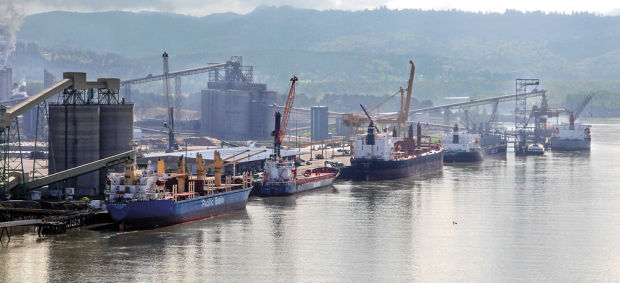forum
library
tutorial
contact

Industrial Growth: Columbia's Deeper
Channel is a Magnet for Big Business
by Shari Phiel
The Daily News, May 25, 2014
|
the film forum library tutorial contact |

|
Industrial Growth: Columbia's Deeper
by Shari Phiel
|
 The $200 million Columbia River channel deepening project, which was derided by some critics as a political boondoggle that would never pay for itself, has been a smashing economic success, lower river port officials and others say.
The $200 million Columbia River channel deepening project, which was derided by some critics as a political boondoggle that would never pay for itself, has been a smashing economic success, lower river port officials and others say.
"Without a doubt, deepening of the channel has made the entire Columbia River system more competitive," said Patrick Trapp, director for the Port of St. Helens.
The deeper channel has brought more than $900 million in capital investments into the region, according to the U.S. Army Corps of Engineers. Billions of dollars more are in the works. Methanol, crude oil, grain expansion and coal projects proposed or already completed in Cowlitz and Columbia counties probably would not have occurred had the corps not deepened the channel, formerly 40 feet, to 43 feet, proponents of those projects say.
The project is the main reason the region is seeing interest from companies that sell or move bulk commodities, which require deep-draft vessels that could not fully leave fully loaded in the shallower channel.
"The deepening of the channel can be directly related to attracting large tenants, such as EGT," said Ashley Helenberg, spokeswoman for the Port of Longview. "Following the completion of the project, many investments were made along the channel."
It took only a few years to deepen the shipping channel from the mouth of the river to Portland, a 103-mile stretch. Before the digging began, though, it took nearly 20 years of study and political fighting to get the project authorized and funded after the ports of Longview, Kalama, Woodland, St. Helens, Portland and Vancouver first asked the corps to study the feasibility of the project in 1989.
The ports first proposed deepening the channel by 5 feet, but the corps soon learned that too much rock had to be blasted to make the project pencil out. The 43-foot channel became a fallback position.
Early on, environmental and fisheries groups faced off against the Corps, filing lawsuits to stop the dredging project. The groups were concerned that dredging would release toxins in the water and damage critical wildlife habitat. They also challenged the Corps' economic analysis of the channel-deepening, claiming the agency had exaggerated the economic benefits of the project. The Portland Oregonian, the region's largest daily newspaper, published a major report challenging the Corps' economic analysis. (Federal rules require any water project to return at least as much economic activity as the project costs.)
Eventually all of the lawsuits and appeals were dismissed, although some concessions were made. To compensate for dumping dredging materials, the corps agreed to 736 acres of environmental mitigation work, and another 4,000 acres of restoration work for riparian and wetland habitats. Some, but not all of the work has been completed.
Nina Bell, executive director of Portland-based Northwest Environmental Advocates, helped lead the fight against the project. She says her concerns about the project haven't gone away. Studies , including a recent on completed by the U.S. Geological Survey, show "the lower Columbia River is a repository for toxins throughout the basin," Bell said.
She added there are hidden costs to dredging, citing erosion on the Oregon and Washington shores and undercutting of the jetties at the mouth of the river because dredges are removing so much sand from the system. "The dredging just adds insult to injury. It's just making it worse. It takes what little sand might be available and takes it out of the system entirely," she said.
There is no denying, though, that deepening the river is bringing new business here.
Since the dredging project was completed in 2010, the EGT grain elevator -- the first new grain elevator built in North America in years -- was built in Longview for $230 million. Another $136 million in grain terminal improvements are being completed at Port of Kalama, and Port of Portland and Port of Vancouver brought in more than $580 million for rail freight projects, new exports at grain elevators and berth deepening investments.
"There's no question about it. We saw that growth begin to payoff as they neared the channel completion. Once the commitment was made and digging began - that's what brought that new elevator to Longview. I don't think they would be here had they not deepened the channel. Every grain elevator on the river expanded their capacity by 20 or 30 percent based on their capacity to move more," said Columbia River pilot Capt. Paul Amos.
The deeper channel was critical to getting Northwest Innovation Works, a Chinese concern, to agree to build two methanol production plants -- one in Kalama, one near Clatskanie -- that will employ 240 people at each site when at full capacity, said Port of Kalama's Liz Newman.
"The deeper channel allows more capacity per ship. Not only has this brought more interest to our North Port, including Northwest Innovation Works, who signed, but both grain terminals located at the Port of Kalama have added (or are adding at TEMCO) capacity since the channel deepening."
Related Pages:
When the Terminal's Done, Who Will Supply the Grain? by Erik Olson, The Daily News, 11/28/9
learn more on topics covered in the film
see the video
read the script
learn the songs
discussion forum
